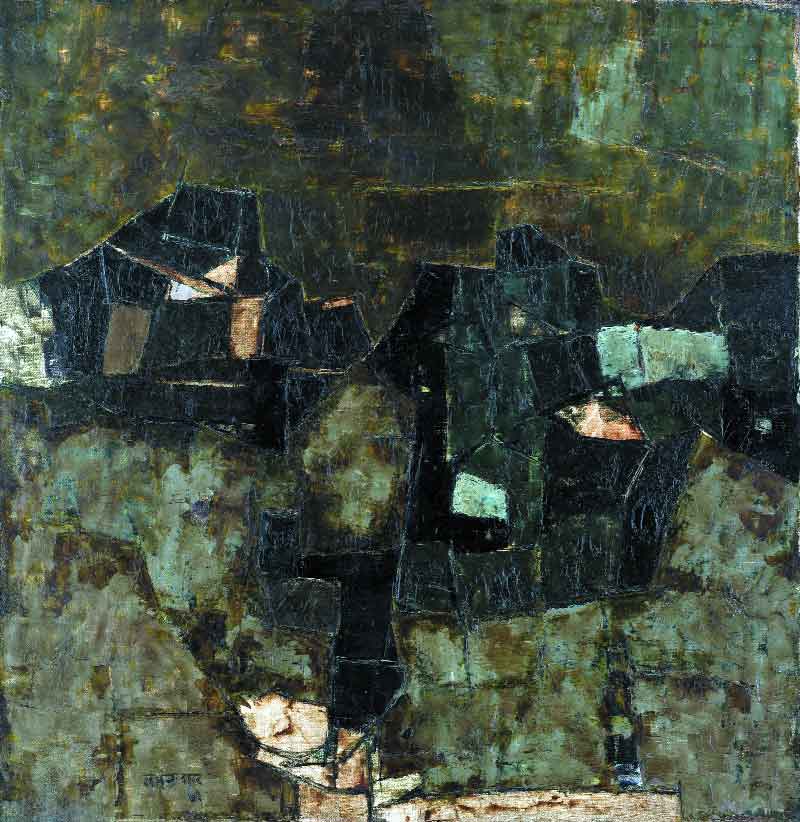It’s good to look at some unforgettable landscapes, especially when they come from two stalwarts of the Indian contemporary art world, Ram Kumar and Krishna Reddy, whom we lost last year, says Uma Nair
The year 2018 saw two stalwarts of the Indian contemporary art world pass on. The venerated abstract master of landscape Ram Kumar (1924-2018) and the pioneer of the print viscosity technique and mentor Krishna Reddy (1925-2018). It is time to assess their unforgettable legacy that hopefully will inspire new artistes.
Ram Kumar
When it comes to landscapes, nobody can hold a candle to the gentle soul Ram Kumar. Among his finest works are a tranquil landscape of 1961 that venerates the tightly knit houses of Varanasi, and a study titled The Boats of 1968. Ram’s works became his signature in the 1960s.
For most of his subsequent career, his work was abstract, often subtly shifting, jagged patchworks of monochromatic lines, blocks and plains. In the year 1969, he travelled to the United States and Mexico through a scholarship from Rockefeller. And when 70s came, much of his work was based upon his personal recollections of experiences and memories of travels to remote mountainous, spiritual centers in Northern India, Machu Picchu and Buddhist monasteries of Ladakh.
Critic Ranjit Hoskote said, “Over the late 1950s, Ram Kumar shifted away from these melancholy evocations and towards landscapes in which he explored the archetypal presence of Varanasi — Hinduism’s most sacred city — a site of acute polarities. In Varanasi, where religion and corruption are often interwoven, where the zones of faith and torment intersect, he found a potent symbol to denote human suffering under the tyranny of putrefying social customs.”
The finest composition done in tones of studied restraint was The Boats. Perhaps what entices is the truth that this work has romanticism about it. The deep moss like tone and the spectral structure of the boats done in feather weight wispiness speak about his early aptitude for abstraction and formlessness.
Ram Kumar addressed himself to the formal aberrations of mismatched planes, jamming the horizontal perspective against top views inspired by site-mapping, aerial photography and locking the muddy impasto-built riverbank constructions into a cubist geometrical analysis. Gradually, the architecture drained away from his canvasses, society itself passed from his concerns, until during the late 1960s, his paintings assumed the character of abstractionist hymns to nature.
He spent the latter part of his life in search for transcendence and awakening. “When one is young and a beginner, one’s work is dominated by content, and ideas,” he said, “but as one grows older, he/she turns to the language of painting itself. I have grown detached. I want to find the same peace that the mystics found.”
Krishna Reddy
No one can ever forget the path-breaking practice of Krishna Reddy, the nonagenarian sculptor and pioneering printmaker who had a range of work that encompassed his career spanning over seven decades, keeping impression-making at the core of his discipline.
Reddy consistently experimented with form, technique and application. Initially he was trained in Tagore’s Santinketan under the tutelage of the influential Ramkinkar Baij. He moved to London in 1949 to study sculpture at Slade in Henry Moore’s class and subsequently spent over two decades in Paris, first at the studio of Ossip Zadkine and eventually directing Stanley William Hayter’s Atelier 17, where he developed and invented the process that he is quite well known for – simultaneous multicolor viscosity printing. He was a co-director of Atelier 17 since 1965. When Reddy joined Atelier 17, it was already a thriving hub for stalwarts like Joan Miro, Constantin Brancusi, Pablo Picasso, and Alberto Giacometti, with all of whom he closely worked. This provided a platform to him for breaking new ground in intaglio printmaking. In collaboration with Hayter, Reddy developed a new technique in multi-colour printing by utilising variable viscosities of the printing inks. In experimenting to develop multi-colour simultaneous printing, Reddy constantly pushed the boundaries that were not only confined to the formal process of printmaking but a revolutionary way of thinking on how to develop a new form.
He was able to control the viscosity of the inks by altering the oil consistency in each impression, thereby allowing the inks to occupy different depths without mixing with each other. Using a range of rollers, he pushed the inks to desired parts of the plate, making spectacular unique mono-prints, rich in their textural quality and dimensionality. Through the 1960s, he travelled the world giving lectures and conducting workshops. After the Paris demonstrations of 1968, he began to spend more time in the US and finally moved to New York in 1976 as director of graphics and printmaking in NYU and went on to teach until retirement, heading the printmaking department at Cooper Union. Dedicating his practice to pedagogy, Reddy’s contributions have been largely undervalued and under-recognised.
Demonstrators and the two demonstration sculptures were created in Paris in 1968, a year marked by cultural, social, and political revolutions in many parts of the Western world. In France, civic unrest and demonstrations reached a boiling point in mid-may after the government closed several universities and arrested student occupiers and their supporters. More than 8,00,000 demonstrators would soon march in Paris alone to express their solidarity with the students and their overall frustration with the government under Charles de Gaulle.
Reddy’s bronze sculpture and etching plates were a piece of history. Using his plates as a sculptural surface for mark-making and engraving, rather than merely using it as a tool for taking an impression, Reddy’s sculptural practice found sanctuary in experimentation with printmaking in a lifelong pursuit to understand form.


























